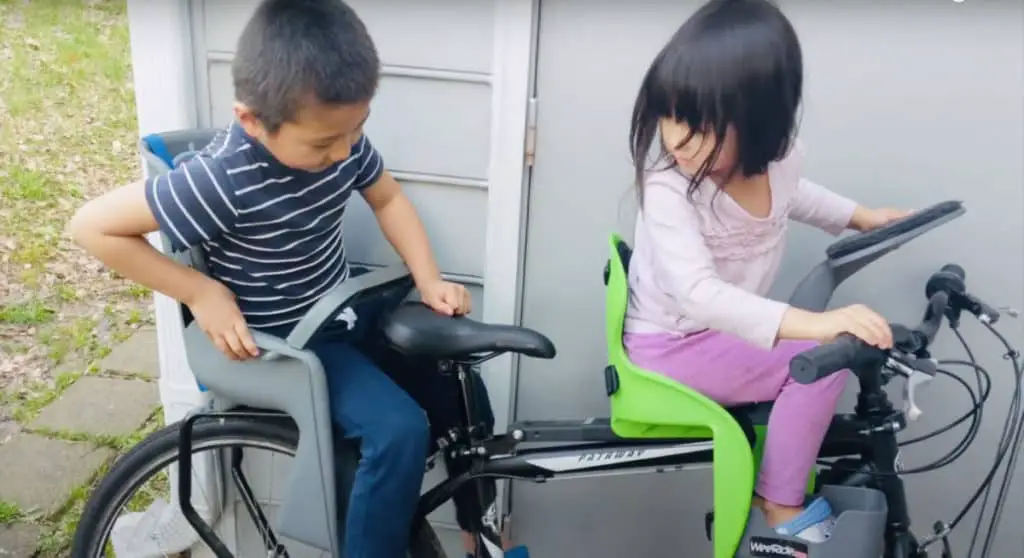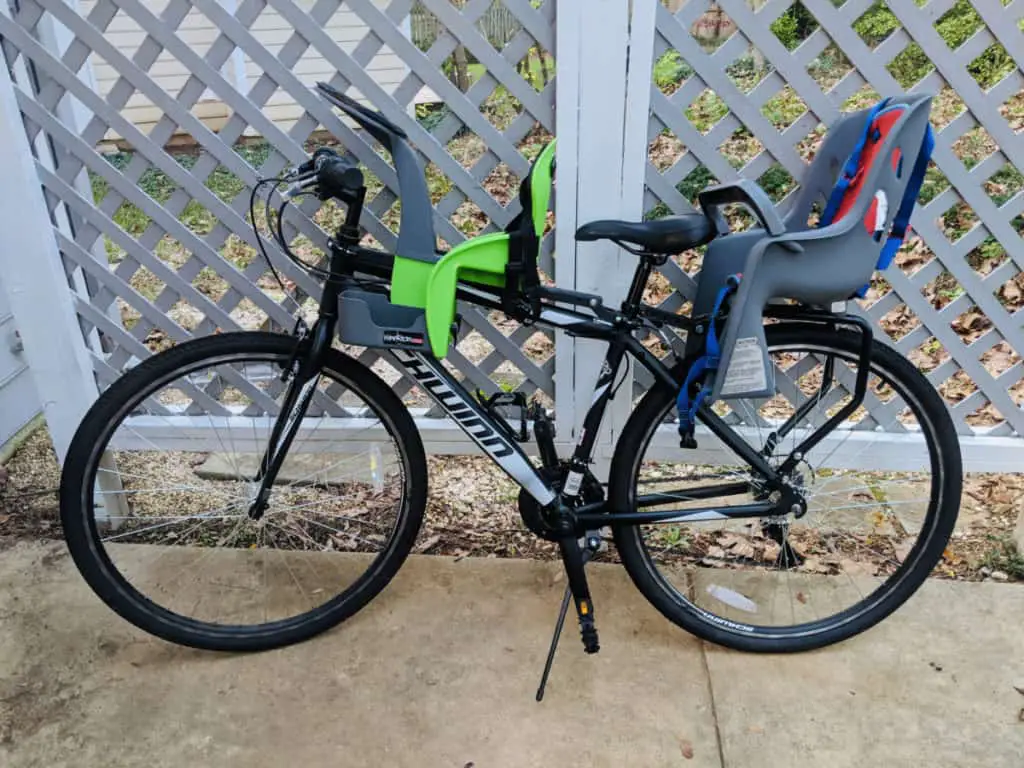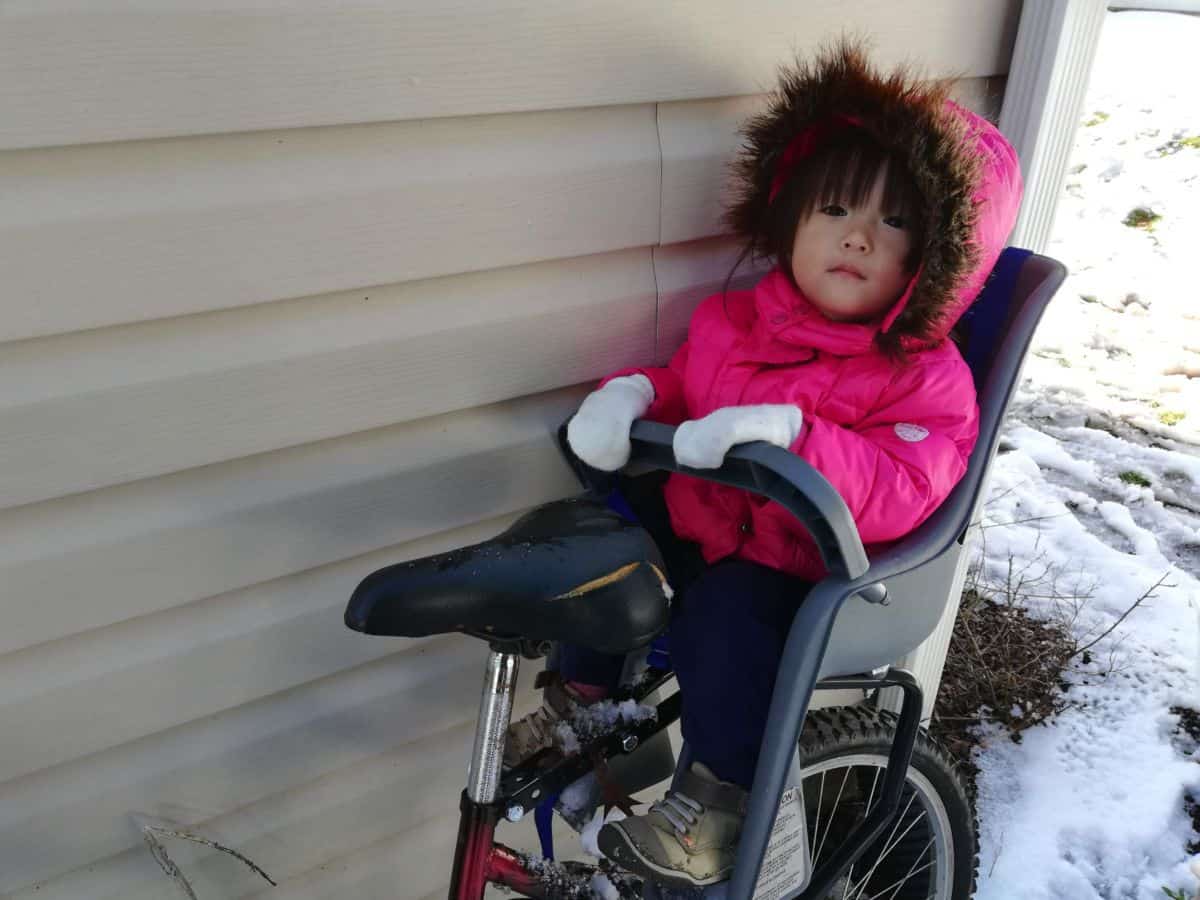Child bike seats come with different setups and attach to your bike in several different ways, including racks and frame-mounted seats. The safest of all the child’s bike seats on the market will mount directly onto your bike’s frame.
Child’s bike seats can attach to your bike without a rack. Most rear child’s bike seats bolt directly to the frame of your bike, and most front seats will attach to the frame or handlebars.
Read on to discover when you may need a bike rack for a child’s bike seat and how to attach it to your bike. Additionally, we will cover how to attach a child’s bike seat to the frame of your bike in situations that allow a frame-mounted seat.
Do you need a bike rack for a child seat?
For any weight over 40 lbs (18 kg), a rack system is required. Rear child’s bike seats can be mounted on the bike’s frame or a rack. Both are completely safe, but rack systems are used for weights that go over 40 lbs (18 kg).
Rear frame mounted seats will often only offer a maximum weight capacity of 40-45 lbs. Ensure you check the seat’s measurements compared to your child’s weight before purchasing one type of seat or another.
The downside is that you will need an adapter kit for each child’s bike seat if you need to install more than one before you can install them on your bike. Not all child’s bike seats come with these kits included, so you may need to make additional purchases to attach these seats safely.
Need to figure out if a rear or front seat is best for you? Be sure to read my guide here.

How to attach a bike rack for a child’s bike seat
For children over 40 lbs (18 kg), you will need to consider a child bike seat that mounts on top of a rack. These are typically installed on bikes with larger frames, so before purchasing a bike rack or child’s seat, be sure your bike is compatible with a rack mount.
Attaching a front bike rack for a child’s seat
Installing a front bike rack for a child’s seat can be an easy process, but an important one to get right for the safety of everyone riding. To install a front bike rack:
- Remove the bolts that anchor your front brake arms and put them over the threaded holes in the bike.
- Make sure to align them with corresponding threaded holes on either side of a front rack.
- Once you have them aligned, use nuts to fasten one end of each bolt in place before moving on to tighten other ends.
From this point, the bike seat adapter can be attached to the rack. These instructions are dependent on the type of child’s seat you purchase but will be included in the seat’s packaging.
Attaching a rear bike rack for a child’s seat
To attach a rear bike rack, you’ll most likely be attaching to a seat post. Seat posts are typically exposed, which means installation is relatively quick and easy. Most seat posts have collars That attach with two or four bolts. The relative simplicity of this type of rack makes it an efficient option for attaching a bike carrier to a bike frame if you’ve got the right kind of clamp(s) available to do so.
- Attach the rack stays onto the rack.
- Attach the rack stays onto the lower leg and fork.
- Connect the child’s bike seat adapter kit (if purchased) to the rack-mounted child’s bike seat from behind using standard hex keys.
- Attach the rear of this child’s bike carrier directly into one side of your bike frame through an opening under it with two screws for added security — but be sure not to overtighten these!
Both front and rear racks follow similar installation processes but check for specific instructions on the rack that you have purchased. Once your rack is installed, you can attach the child’s seat to the rack by following the instructions provided.

How to attach a child’s bike seat to a bike rack
To attach the child’s bike seat to your newly installed rack, begin by removing the child’s bike seat from the box and finding all of the attachments and directions for installations.
- Find the adapter kit for your child’s bike seat and remove it from the packaging. Following instructions included with your child’s bike seat, attach the fitting to either side of a bike rack.
- Attach leg brace with socket arm (provided in child’s bike seat package) to top of the left mounting hole on adapter plate assembly by inserting a bolt into the right-hand end or vice versa if you are using the opposite-handed system. Tighten bolts firmly until they don’t turn anymore.
- Place the child’s bike seat onto fittings on a rack that has been secured with locking nuts so that the bottom of the child’s bike seat is just above the child’s seat post.
- Tighten the child’s bike seat with an Allen wrench to avoid any slippage after the child has been riding for a few minutes.
- Check all connections for security and adjust as needed before letting your child ride away.
Be sure to adjust the child’s bike seat forward or backward on fittings until the child can reach pedals comfortably and check all the connections to ensure that your child cannot loosen them.
How do child bike seats attach to a bike’s frame?
To attach a child bike seat, you need only two tools — an Allen key wrench for tightening the nuts/bolts and a Phillips head screwdriver for taking up slack to tighten the clamping screws against either the handlebar grips or chainring (depending on where it attaches).
The child bike seats that bolt directly onto the frame are as safe and secure as any other bike seat. The child’s bike seat will be secured with a bracket to one side of your front or rear wheel, which is then bolted on tightly using several nuts and bolts.
Important points when using a rack system
A rack system is suited for bikes without sufficient low-hanging clearance underneath them because they offer a lower profile and can be attached to the top tube of your bike. Rack systems fit bikes that don’t have enough low-hanging space under them.
If you’re using a rack system, it’s important not to install it too close to the back wheel because this could cause instability when riding up hills. Ensure any attachments have enough clearance from all moving parts, so they don’t get caught while biking.
Important points when using a frame mounted seat
Frame mounts are typically for seats that don’t have mounting hardware. Mounts are usually attached to a bike’s front or rear fork, which offers an even lower profile than racks. The child bike seat can be installed at its lowest level and still allow full clearance for the handlebars when operating on either kind of mount.
Whether you decide to use a rear or front child bike seat, there are some things to keep in mind. A good place for the mounting point is at least 4 inches below the top of your saddle and in an area that won’t interfere with pedaling.
Rear-facing seats are mounted onto your frame, so they attach right up to you for easy control of braking and steering and make riding more comfortable because there isn’t any additional weight on their backside (plus, no bouncing!).
Here’s a short video explaining what I think the best options are for riding with a child.
Conclusion
The rack system is the most popular type of bike carrier for bikes with no low-hanging clearance. Rack systems are attached to your bike top tube and provide a lower profile, unlike other options, which mount on the back wheel or frame in some cases without providing any security.
A child’s seat can also be mounted onto either a rack system or directly onto your bike’s frame if it does not have sufficient low-hanging clearance underneath. Rear-facing seats are also, an option that attaches right up against you, so they’re easy to control when braking and traveling downhill!
Though rear child bike seats are generally considered safe, it really comes down to your confidence and comfort level while riding a bike. It’s a good idea to practice riding with extra weight before buckling your child into the seat and always ask for help if you need it. And don’t forget, always wear a helmet!
My Recommended Child Bike Seats
Affordable and sturdy, I recommend getting the following child bike seats for anyone looking for a seat to ride together with your child. I’ve been using these two seats for more than 6 years for both of my kids and they’re still holding up great. If you want to see all the gear I recommend, check out my Gear page.
Recommended Front Child Seat: WeeRide
Recommended Rear Child Seat: Schwinn Deluxe

